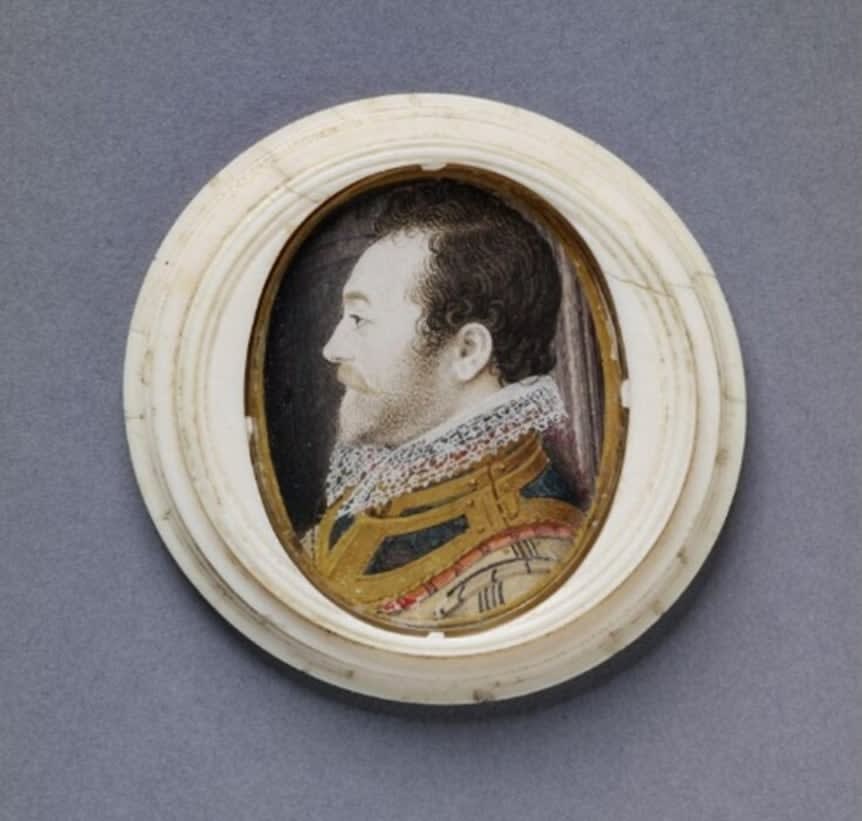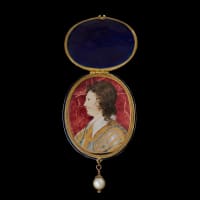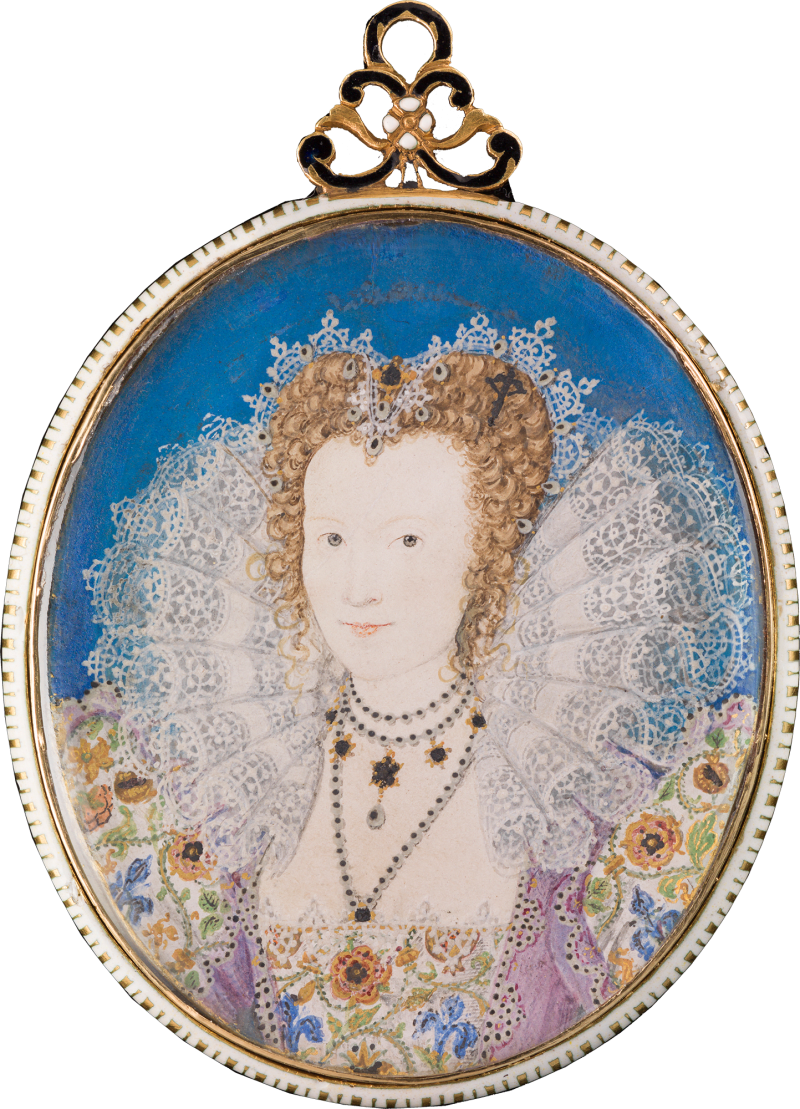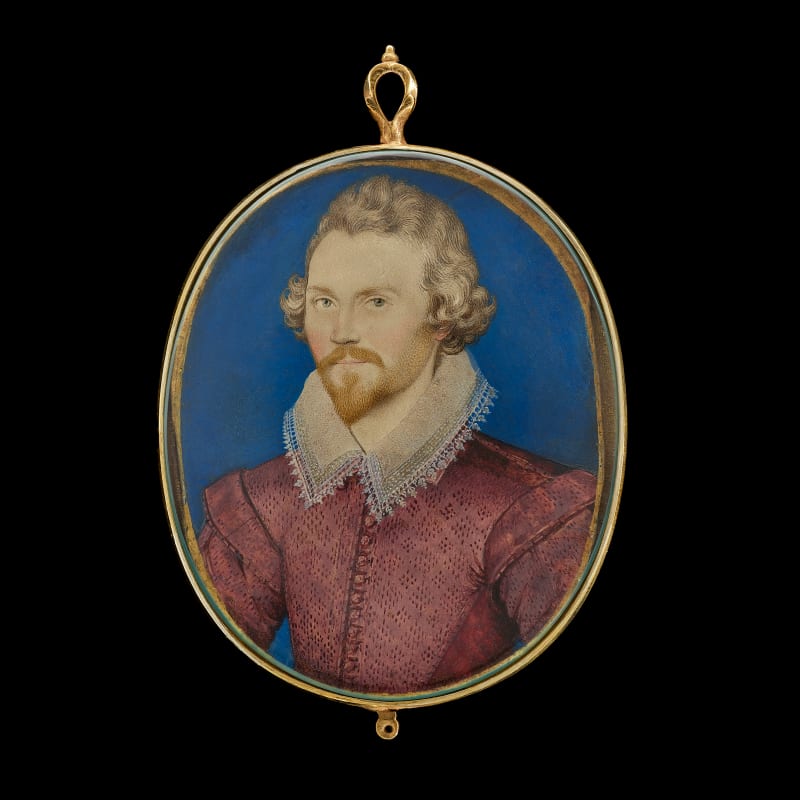Sold out
For all available works visit philipmould.com
This highly distinctive portrait by Nicholas Hilliard is seemingly one of only two extant profile miniatures painted by him. The closest example would appear to be the portrait of a gentleman of the Barbor family, now in the collection at the Victoria and Albert Museum, London [fig. 1].[1]Dating to the last five years of the 16th century, this profile portrait demonstrates Hilliard’s desire, likely against the background of emerging competition from his former pupil, Isaac Oliver (c.1565-1617), to introduce fresh innovation to the traditional limning format. It is during this period that Hilliard’s ‘wet-in-wet’ technique was initiated, to emulate the red velvet curtains which habitually hung as the background for portraits.[2]
From the emergence of the present image, and from the profile portrait of the member of the Barbor family, it would appear that Hilliard was also experimenting with new ways of presenting the face in miniatures. Conventionally, portrait miniatures,...
For all available works visit philipmould.com This highly distinctive portrait by Nicholas Hilliard is seemingly one of only two extant profile miniatures painted by him. The closest example would appear to be the portrait of a gentleman of the Barbor family, now in the collection at the Victoria and Albert Museum, London [fig. 1].[1] Dating to the last five years of the 16th century, this profile portrait demonstrates Hilliard’s desire, likely against the background of emerging competition from his former pupil, Isaac Oliver (c.1565-1617), to introduce fresh innovation to the traditional limning format. It is during this period that Hilliard’s ‘wet-in-wet’ technique was initiated, to emulate the red velvet curtains which habitually hung as the background for portraits.[2] From the emergence of the present image, and from the profile portrait of the member of the Barbor family, it would appear that Hilliard was also experimenting with new ways of presenting the face in miniatures. Conventionally, portrait miniatures, or limnings as they were then called, showed the face directly gazing out at the viewer. This reflected their use as highly personal objects, often commissioned to be exchanged during courtship; or as diplomatic gifts, with the portrait acting as proxy for the individual. The unusual decision to be painted in profile (possibly the request of the sitter) is difficult to fully comprehend without knowing the certain identity of the patron. The work foreshadows Isaac Oliver’s profile portraits of Henry, Prince of Wales and his mother, Anne of Denmark. In choosing this pose, Oliver and his patrons alluded to the ancient Roman empire - its power and authority – Prince Henry more specifically reinforcing this notion in his classical style clothing.[3] A growing interest in the collecting of Roman coins and cameos also made this a fashionable pose in the first quarter of the seventeenth century. This portrait, however, predates this fashion in miniature, indicating a more private reasoning behind the pose. Although the sitter in this miniature is presently a subject of some debate, a clue to his social status can be found in the armour he has chosen to wear. The armour is of the Greenwich style of the 1580/90s. The upward lapping plates of the pauldrons (shoulder defences) are typical of the style at that time, as is the composition of the etched and gilt decoration.[4] The armour would have been painted by Hilliard using ‘shell gold’ - ground gold leaf which was then ground with honey and burnished with a tooth to make it smooth and reflective. Greenwich armour was typically worn not for combat but for jousting. As a favourite sport of Henry VIII, his daughter Elizabeth made jousting a prime feature of her calendar through the introduction of Accession Day Tilts, held at the Tiltyard in the grounds of the Palace of Whitehall.[5] The armour may provide a clue to the identity of the sitter, as this type of jousting armour, made in the form of a garniture (the individual parts known as ‘pieces of exchange’) was designed specifically to mirror the personality and status of the sitter. It can be assumed that Hilliard was as meticulous at recording detail on armour as he was at recording specific jewels. The ‘Almain Armourer’s Album’ (known as the ‘Jacob Album’) is a book of designs by Jacob Halder, who worked on specific commissions from high profile courtiers who were usually close to the queen’s inner circle. As the Victoria and Albert Museum website explains; ‘The production of armour was a highly sophisticated process. The designs in the Album record armours whose manufacture combined the skills of the artist, the tailor, the blacksmith, the goldsmith, the engineer and the locksmith. Their use demanded the skills of the courtier, the soldier, the diplomat, the sportsman, the actor and the daredevil.’[6] There are pictorial, iconographical, and circumstantial reasons to suggest that the sitter here is Sir Robert Dudley (1574-1649), son of Elizabeth’s favourite, Robert Dudley, Earl of Leicester (1532/3-1588) and Douglas Sheffield, Lady Sheffield (1542/3-1608). Likely born out of wedlock, Sir Robert spent much of his life attempting prove himself as the legitimate son of Leicester. The features of the sitter in this profile miniature accord closely with a full-length portrait of Robert Dudley dating to circa 1590-95.[7] This would have been a significant time for Dudley – he married Margaret Cavendish (d.1595), daughter of William Cavendish of Trimley St Martin (Suffolk) (likely they married circa 1591). Significantly, he was also on the ‘tilt list’ of 1591, jousting in his first Accession Day Tournament. If the portrait does indeed show Dudley, it is likely that both this and the cabinet miniature was also commissioned for these momentous events in the seventeen-year old’s life. The choice to have a portrait painted in profile may relate to a coin with a profile of his father, minted for the Province of Zeeland, Netherlands, in 1586.[8] Furthermore, the closest depiction of this design of armour can be seen in Hilliard’s full-length, unfinished portrait of Dudley’s father, at Parham Park, West Sussex. As Elizabeth Goldring writes in her biography on Nicholas Hilliard, from the late 1580s, ‘a new generation of courtiers – born after Elizabeth’s succession – was jostling for power and influence.’[9] This group of young men, which included Sir Philip Sidney’s stepson (and Hilliard’s new core patron) Robert Devereux, Earl of Essex (1565-1601), Robert Dudley, Leicester’s ‘natural’ son and a host of plucky and handsome young men. Hilliard’s artistic response, with Oliver already appropriating some of his patronage, was to provide his sitters with majestic, full length ‘cabinet’ miniatures. Hence, a cluster of these images of men in armour appears at this time, including the portrait of Sir Anthony Mildmay of circa 1590-93 and the portrait of George Clifford, 3rd Earl of Cumberland (champion and organiser of the Accession Day Tilt), from circa 1590.[10] As Elizabeth Goldring further points out, the choice of portrait type for the Earl of Leicester – full length and in armour – provided ‘a template for[…]others, thus creating both a visual and a political line of descent’.[11] For this generation of courtiers, largely followers of the new favourite, Robert Devereux, 2nd Earl of Essex, this was a clear visual connection – and one with which the sitter in this profile appears to be associating. Unpublished and unknown until 2021, when this portrait emerged in France from an aristocratic collection, the miniature is a significant addition to Hilliard’s known oeuvre.[12] Hilliard spent two years in France, from 1576 to 1578, his introduction to the court there likely made via Dudley’s father the Earl of Leicester. Although, by the time this portrait was painted, Hilliard had been back in England for a number of years, it seems his international reputation was well-established, with his miniatures regularly witnessed abroad. For example, when Henri IV saw Hilliard’s miniature of Elizabeth I in 1596 he declared ‘he would not forgoe it for any Treasure’ and insisted the English ambassador surrender it to him.[13] The number on the reverse of ‘T329’, likely written in a 19th century hand, provides tantalising evidence that this work was once part of a large collection. Its emergence after over four hundred years is part testament to the secret nature of the portrait miniature, which has always been a feature of their enduring fascination. [1] Victoria and Albert Museum, London (accession number 887:1-1894). So unusual is this format in Hilliard’s oeuvre that this miniature was attributed to Isaac Oliver by Roy Strong in the exhibition catalogue 'Artists of the Tudor Court', 1983, no.143. [2] Elizabeth Goldring notes that the red curtain painted in Hilliard’s wet-in-wet technique was first used circa 1590 (see E. Goldring, Nicholas Hilliard: Life of an Artist, New Haven and London: Yale University Press, pp. 233, 236). [3] Portrait of Henry, Prince of Wales in profile, by Isaac Oliver, c.1610, Fitzwilliam Museum, Cambridge (3903)/ Portrait of Anne of Denmark in Masque costume, by Isaac Oliver, c.1610, The Royal Collection (RCIN 420025). [4] With thanks to Dr. Tobias Capwell, Curator of Arms and Armour, Wallace Collection, London (email communication, May 2021). He also noted ‘The artist has captured lustre of the polished steel especially well.’ [5] These were held on 17 November every year to celebrate Elizabeth’s accession day. [6] Accessed 26 May 2022 https://collections.vam.ac.uk/item/O78116/the-almain-armourers-album-armour-design-halder-jacob/ [7] Nationalmuseum, Stockholm. Dudley here wears a miniature pinned to his shoulder which is similar to the locket which houses the present profile portrait. [8] An example can be seen in the British Museum, registration number G3,FDSC1.6. [9] E. Goldring, ‘Nicholas Hilliard; Life of an Artist’, Yale University Press, Yale, New Haven, 2019, p.207. [10] Mildmay’s full-length portrait by Hilliard is now in the Cleveland Museum of Art, while Cumberland’s is in the National Maritime Museum at Greenwich. [11] Goldring, Hilliard, p. 231. [12] The emergence of this portrait mirrors the discovery of Hilliard’s important portrait of Henri III, which was sold in an auction in Paris in 2013 (now Djanogly Collection). [13] The Earl of Leicester, campaigning in the Netherlands in 1586, asked that one of his Dutch allies be sent one: ‘a picture in a tablett, which might be worth £200, would content him as much as £1000 in money’. [13] The Earl of Leicester, campaigning in the Netherlands in 1586, asked that one of his Dutch allies be sent one: ‘a picture in a tablett, which might be worth £200, would content him as much as £1000 in money’. |






